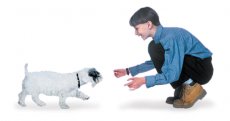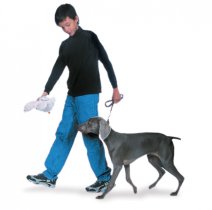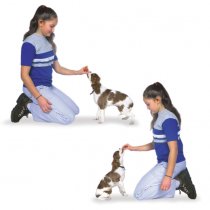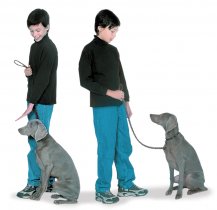Different ways to train a dog

Getting Started
To start off on the right foot (and paw!) with your pup, he’ll need to know what you expect from him. This will make him feel secure in his ability to meet the goals laid out for him going forward.
The foundation of training is based on correction and reward. Correction should never be harsh or angry, and should never involve physical punishment such as spanking or hurting your dog. All you need is your voice: A firm “No!” is enough correction for most puppies.
A reward is simply anything your dog likes a lot. Most people use small bits of a “high value” food for training treats—something special—such as dried liver or particularly tasty dog biscuits. Lavish praise or the chance to play with a favorite toy can also be used as a reward. Dogs have to be taught to like praise. If you give the dog a treat while saying “Good dog!” in a happy voice, he will learn that praise is a good thing and can be a reward in itself.
Puppies can begin very simple training, such as wearing a collar or learning about praise, at about 8 weeks. You can begin teaching the basic five commands described below when the puppy is 12 to 16 weeks old. Always keep training sessions brief—just 5 to 10 minutes at a time, at first—and always end on a positive note. If your puppy is having trouble learning a new command, end the session by reviewing something he already knows and give him plenty of praise and a big reward for his success. If your puppy gets bored or frustrated it will ultimately be counterproductive to learning.
If your puppy gets bored or frustrated it will ultimately be counterproductive to learning.
How To Teach A Dog To Come
You'll want to begin training this command in a quiet area, and indoors. First move into a squat position, with your arms open wide. Say the word "Come." If she starts moving toward you, give her verbal praise. Like all training, use a happy, encouraging tone of voice. You want her to think that the process is fun, not scary.
Whatever you do, don't reach out and grab her as she gets close to you. That will confuse her. When she gets really close, just gently reach out, offer a soft stroke of belly or head, and verbal praise. And if she is food motivated, this would be a good time to offer a yummy treat.
 Other actions, such as "Sit" will be added next, but for right now, getting your puppy to stop right in front of you is the goal.
Other actions, such as "Sit" will be added next, but for right now, getting your puppy to stop right in front of you is the goal.
If your puppy doesn’t come to you, go slowly to him, attach his leash, then guide him back to the spot where you called him. Praise him the entire time you are leading him there. This shows him that he has to obey, but that you’re not angry with him. Never scold him for coming too slowly, and don’t ever call him to you in order to punish him—you’ll only teach him to avoid you.
Further Reading
How To Teach a Dog To Heel
In traditional dog training, “Heel” means that the dog is walking on your left side, his head even with your knee, while you hold the leash loosely. Puppy training can be a little more relaxed, as long as you don’t pull your dog along or let him get ahead and pull you. Some trainers prefer to say “Let’s go” or “Forward” instead of “Heel” when they train this easy way of walking together. Whatever command you choose, be consistent and always use the same word.
 Start with your dog standing next to you. Hold his leash in your left hand and a squeaky toy in your right. Place your right arm across the front of your body so the toy is above and slightly in front of your dog’s head. Encourage him to look up at the toy as you give the command and step forward with confidence. Your puppy should step forward with you as he follows the toy.
Start with your dog standing next to you. Hold his leash in your left hand and a squeaky toy in your right. Place your right arm across the front of your body so the toy is above and slightly in front of your dog’s head. Encourage him to look up at the toy as you give the command and step forward with confidence. Your puppy should step forward with you as he follows the toy.
Keep the puppy’s attention on the toy as you walk forward together. If the puppy gets distracted, squeak the toy, get his attention, and praise him. Also praise the pup if he looks up at you. This is called “checking in, ” and it’s a good thing to encourage.
After your puppy has given you 20 or 30 seconds of attention, give him the toy. Play with him a bit, then relax and try walking again. Gradually increase the time you walk together during your training sessions, then gradually stop using the toy. Eventually your dog will walk happily at your side whenever he’s on his leash.
How To Teach a Dog To Sit
There are two different methods for showing your puppy what “Sit” means. Use whichever one works best for your dog.
how to explain a teacher how much system data iphone where are lf system from how many entrepreneurs where is sewerage system from how many design principles are applied for industry 4 0 dance where solutions why startup repair windows 7 how far technology has come how many solutions does the pair of equations where to start startup which product results from the breakdown of fibrin how many london bridges have there been why device manager can't open why technology is bad how much solution in contact lens case which product is required to be sterile quizlet what is the difference between a roadmap and a timeline where was a teacher filmed 2020 how much business class qatar airways where to download project sekai how much system unit when project management goes wrong how many product searches start on amazon how far phone from eyes when business partners fall out how much system memory do i need when project runway season 20 how many development region in nepal when solution is simple god is answering who teach you how many london stabbings 2021 what teaching looks like how many manager does wizkid have where to get technology news how far london to ireland what entrepreneur does how much product designer earn where business logic in mvc pattern how to state a solution why product design is important whose teaching the zoroastrianism is based on where to find entrepreneurs how far into the future does a solution roadmap forecast how many management theories are thereRelated posts:

 Training your dog to do advanced tricks like finding something or bringing their food bowl can be done with just 10 minutes a day and some clicker training. It’s…
Training your dog to do advanced tricks like finding something or bringing their food bowl can be done with just 10 minutes a day and some clicker training. It’s… MARY ISENHOUR-LONG Owner - Trainer Photo by Stewart Event Images About The Trainer The phrase, “gone to the dogs”, is certainly an appropriate one to describe my…
MARY ISENHOUR-LONG Owner - Trainer Photo by Stewart Event Images About The Trainer The phrase, “gone to the dogs”, is certainly an appropriate one to describe my… 6 Principles of Successful Training 1. Be Consistent: Apply the same rules and the same words all the time. 2. Be Concise: Give your command just once. Repetition…
6 Principles of Successful Training 1. Be Consistent: Apply the same rules and the same words all the time. 2. Be Concise: Give your command just once. Repetition… Cesar Millan Cesar is a best-selling author, public speaker, and internationally acclaimed star of the TV shows “Dog Whisperer with Cesar Millan, ” “Leader of the…
Cesar Millan Cesar is a best-selling author, public speaker, and internationally acclaimed star of the TV shows “Dog Whisperer with Cesar Millan, ” “Leader of the… At Monument Dog Training, we believe that change is always possible . We regularly resolve aggressive behavioral issues, even with dogs who have been written off…
At Monument Dog Training, we believe that change is always possible . We regularly resolve aggressive behavioral issues, even with dogs who have been written off…